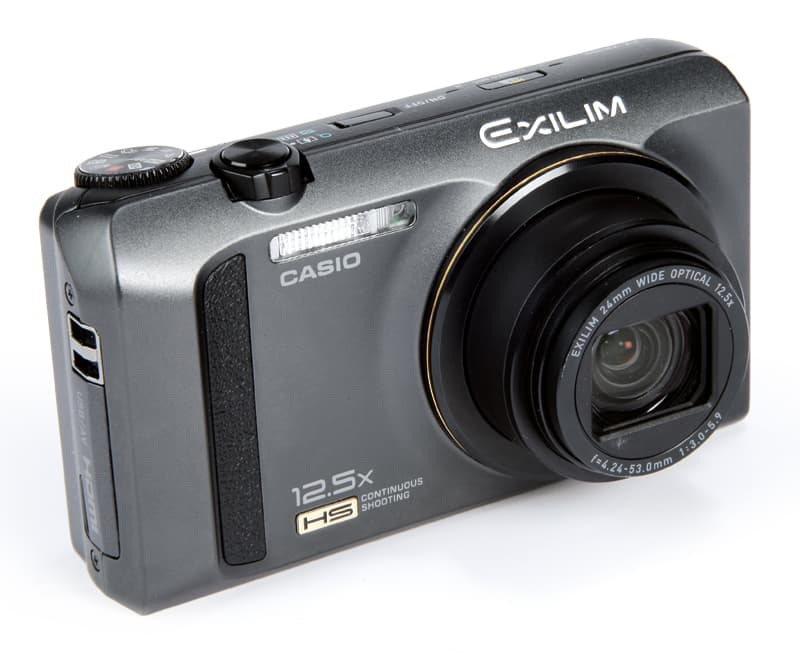Most photographers require a compact camera to satisfy two requirements: to fit easily in a pocket and to provide enough control over their images so they can get creative, should they wish.
The so-called ‘travel compact’ is generally considered the ideal marriage of these two factors, and subsequently it has become popular with DSLR owners.
Casio’s latest compact appears to be pointed towards this area of the market, but with some trademark Exilim features that should distinguish it from the competition.
The Casio Exilim EX-ZR100 features the ‘Exilim Engine HS’ processor, which allows extremely high continuous shooting speeds to be obtained in both still and video capture, and is responsible for its art effects.
Build and Handling
 The sensor is a 1/2.3in back-illuminated CMOS unit with 12.1-million effective pixels and designed to produce lower signal noise, although with JPEG-only saving this will be difficult to determine. The lens ranges from 24-300mm (equivalent) with an f/3-5.9 aperture. The sensor is mechanically stabilised to reduce camera shake and the ISO extends from 100-3200. The metering provides multi-pattern, centreweighted and spot options, with exposure compensation to ±2EV.
The sensor is a 1/2.3in back-illuminated CMOS unit with 12.1-million effective pixels and designed to produce lower signal noise, although with JPEG-only saving this will be difficult to determine. The lens ranges from 24-300mm (equivalent) with an f/3-5.9 aperture. The sensor is mechanically stabilised to reduce camera shake and the ISO extends from 100-3200. The metering provides multi-pattern, centreweighted and spot options, with exposure compensation to ±2EV.
The autofocus system offers a choice of spot, multi, intelligent and tracking modes. There are also continuous focusing and face-detection options, plus macro, super macro, infinity and manual focus, although only from within certain modes. Even in low light the focusing performs well, aided by a strong AF lamp, but the motor is fairly loud and takes around 1sec to focus, so it is slow compared to other models we’ve tested.
The exposure modes include manual, shutter and aperture priority settings, although with an aperture limited to just two positions at any one focal length it isn’t quite as free as you might hope.
Other shooting modes include panorama, which can produce up to 360° shots in a single movement; best selection, which fires a quick burst to achieve the best image; best shot, which provides scene mode-type selection; and premium auto, for auto scene selection. The HDR mode combines multiple shots for a more balanced overall exposure. HDR art takes HDR to its more extreme ends with a choice of three levels to heighten the degree of the effect.
The high-speed continuous shooting switches to a more modest 10-million-pixel resolution, which can be forgiven when it offers up to 30 frames to be taken at speeds from 3-40fps. The EX-ZR100 also uses a system called SR zoom to extend the range from 12.5x up to 25x by combining multiple shots.
For video, the camera offers Full HD video (1920×1080 pixels) at 30fps. The high-speed functionality also extends to movies, with up to 1,000fps at lower resolutions.
The design of the EX-ZR100 is clean and simple, with minimal buttons and a dark-grey finish. The casing features a small lip in the front with a rubberised patch to aid grip and sits well in the hand. However, the lens barrel has a bit of a rattle and many controls require menu access. The LCD is a 3in, 460,800-dot device that is clear and bright enough to use in all conditions.
Performance

Image: Images at low ISO sensitivities are well detailed with slightly cool colouring from the auto white balance
Images are bright and natural, while colours appear slightly muted overall. There are hints of chromatic aberration in high-contrast areas, but not to any worrying extent. At ISO 3200 colour noise is well controlled, but the noise reduction that is applied leaves detail almost non-existent. Below ISO 400 the detail is far more impressive with crisp edges, but there are still signs of artefacts in the image when viewed at 100%.
The auto white balance can leave images looking cold on overcast days and vary across a shoot. For indoor tungsten lights, however, it gives a natural, slightly warm colouring. The metering leaves a balanced exposure, although where the dynamic range is exceeded the highlights are first to suffer.
Using the standard HDR mode can help gather more tonal range for an image and the results remain fairly natural. The HDR art settings, however, are more extreme and are unlikely to appeal even to the most fanatical HDR users.
Our Verdict
The Casio Exilim EX-ZR100’s strength is its high-speed abilities, and if you want a camera that can shoot fast at a relatively high resolution this model could be for you.
In terms of manual control it is a bit limited, and there are plenty of cameras already on the market that offer greater control and zoom for similar money.







